



Suggested citation: Tyagi, Akanksha, Charu Lata, Jessica Korsh, Ankit Nagarwal, Deepak Rai, Sameer Kwatra, Neeraj Kuldeep, and Praveen Saxena. 2021. India’s Expanding Clean Energy Workforce. New Delhi: Council on Energy, Environment and Water, Natural Resources Defense Council, and Skill Council for Green Jobs.
This study, in collaboration with the Natural Resources Defence Council (NRDC) and the Skills Council for Green Jobs (SCGJ), provides updated data on jobs created through India’s on-grid solar and wind energy sectors during FY21 and FY22. It provides updated findings and recommendations geared toward India’s goal of 500 GW of non-fossil fuel electricity generation capacity. It builds on earlier studies on clean energy jobs — Powering Jobs Growth with Green Energy (2019), Greening India’s Workforce (2017) and Clean Energy Powers Local Job Growth in India (2015).
Sector-wise jobs creation potential by achieving 101 GW wind and 238 GW solar targets of non-fossil fuel capacity by 2030.
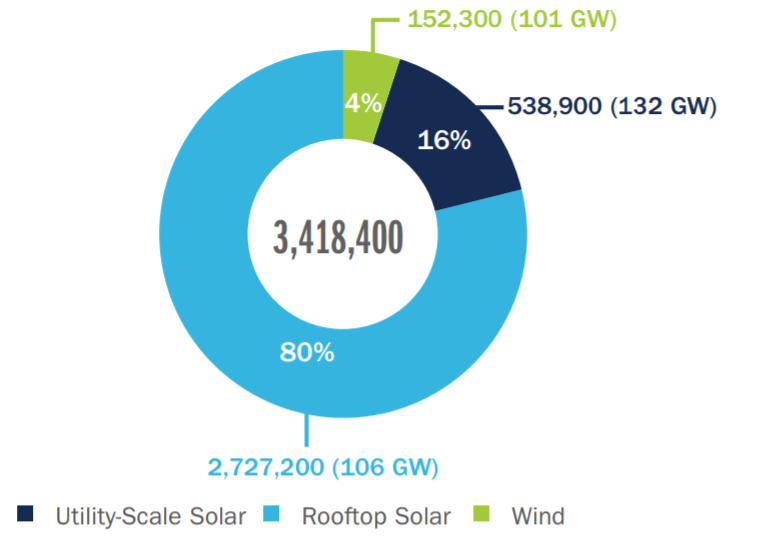
Source: CEEW-NRDC analysis, 2022
Cumulative workforce employed by wind and solar energy sectors as of FY21
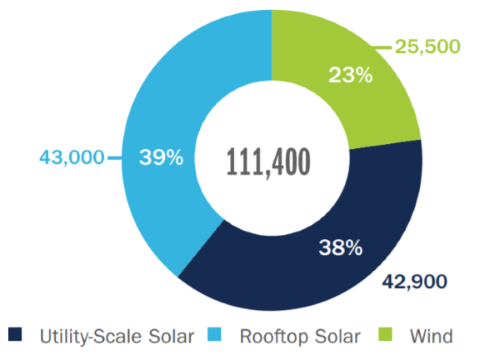
Source: CEEW-NRDC analysis, 2022
Job creation, skill development and COVID recovery are key priorities for the Indian government. Jobs created in the renewable energy (RE) market offer a significant opportunity to meet the government’s multiple goals of employment generation, clean energy expansion, and economic development. As of August 2021, India reached a total installed capacity of 100 GW of RE, excluding large hydro.
This report provides an updated analysis on direct jobs created from solar and wind in financial year 2020 (FY20) and 2021 (FY21), building on earlier analyses by the Council on Energy, Environment and Water (CEEW), the Natural Resources Defense Council (NRDC), and Skill Council for Green Jobs (SCGJ).
This analysis uses the workforce numbers, job-years per megawatt (MW), and full time equivalent (FTE) coefficients calculated in earlier reports from data collected in 2017.This report provides updated findings and recommendations geared toward India’s goal of 500 GW of non-fossil fuel electricity generation capacity, including 450 GW of RE, by 2030.
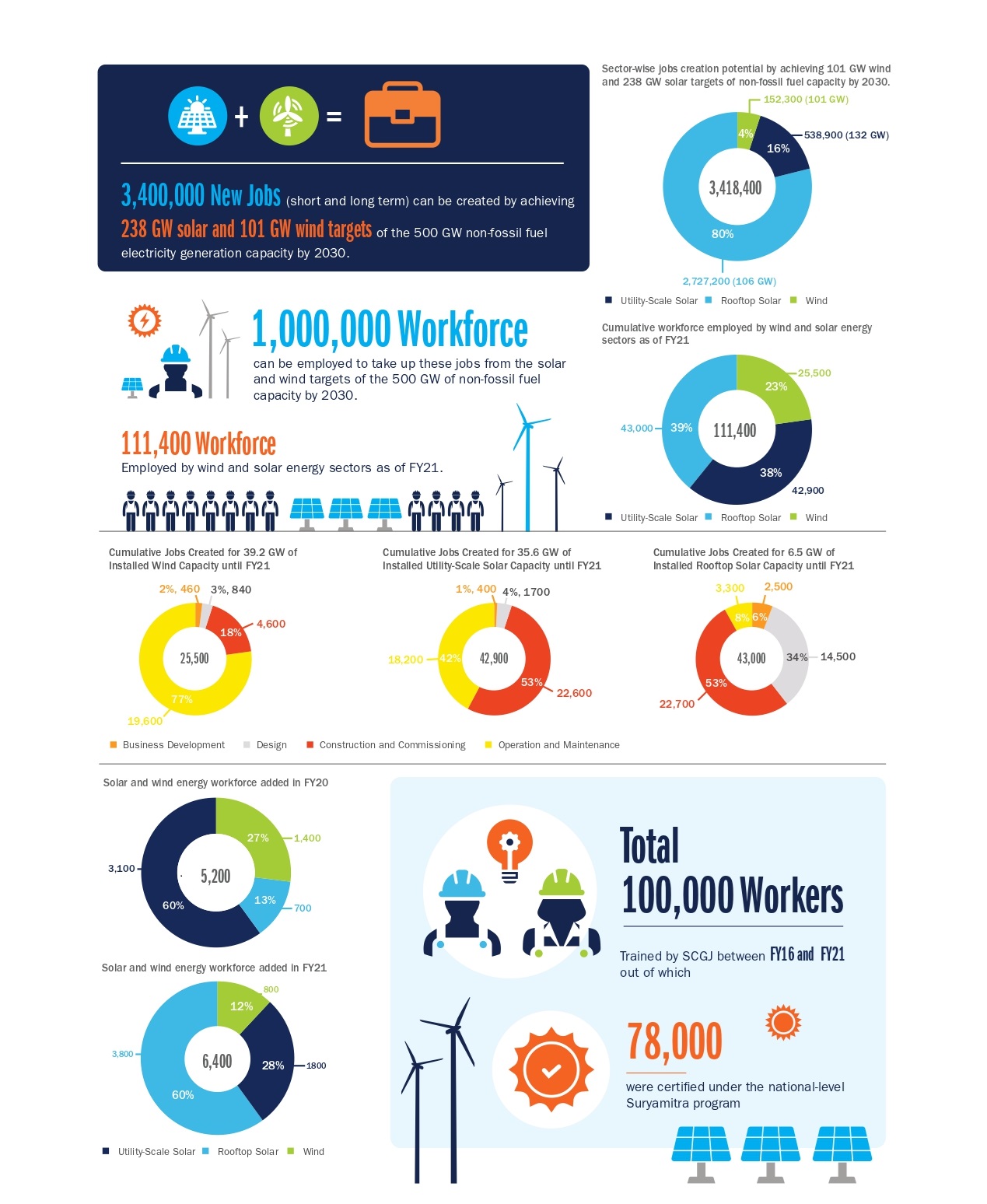
Below are recommendations that can support India develop a trained and skilled workforce to help achieve its 500 GW goal, boost and diversify employment opportunities and develop a robust skilling ecosystem that can cater to the evolving industry needs.
Decentralized RE projects like rooftop solar, mini and micro-grids, biomass and small hydro systems, though smaller in size, have greater scalability potential and avoid the long lead times and execution bottlenecks associated with public-sector offtake procurement projects.79 DRE projects not only create direct employment jobs, but also lead to creation of entrepreneurial jobs from productive use electricity loads such as application of RE in agroprocessing, communications, commerce, education, and other fields. Challenges to expanding off-grid renewables or DRE in India include unclear policy direction, such as on net-metering and import duties on solar modules, information about available technology options, affordable and innovative financial solutions for micro businesses and small consumers, as well as information asymmetry among equity/debt investors constraining companies’ ability to access finance. While rooftop solar remains the mainstay, emergence of diverse business models such as mini and micro-grids, floating solar systems, and biomass to energy projects have expanded the gamut of clean energy applications. These projects can increase the employment opportunities in rural areas to achieve India’s 500 GW nonfossil fuel capacity target. The distributed nature of these projects makes them more labor intensive than utilityscale projects thereby increasing the jobs created across the project deployment cycle. Supporting these businesses with both technical assistance and development (and commercial) finance is crucial to realize India’s off-grid RE potential.
Steady and continual installation of RE projects through periodic tendering can help in retaining the existing clean energy jobs and create new jobs across the RE landscape. Providing relaxations to continue construction activities even in special cases like pandemics, supporting the investments in the sector through streamlined processes, payment securities etc. are other ways to reduce job loss in the sector while ensuring appropriate worker benefits (healthcare, housing, sanitation) and health and safety precautions.
COVID-19 had a higher impact on migrant workers compared to the local workforce. While continuing construction activities during situations like a pandemic, improvements can be made in the working and living conditions of migrant workers.
By June 2021, India had a domestic manufacturing capacity of only 3 GW for solar cells and 15 GW for solar modules. To leverage its growing green energy market in line with the 500 GW target as well as to play a larger role in global supply chains, India needs to create global manufacturing champions by removing sectoral disabilities and creating economies of scale to develop complete component ecosystems in the country. An added advantage of this would be to harness the untapped employment potential from such development.
RE jobs and skill trainings need to be brought to rural areas outside of tier I and tier II cities. India’s rural communities are not yet equipped with the necessary skill sets to access such jobs. To access these jobs, features such as providing access to under-educated youth, ensuring women’s inclusion, and connecting trainees to job platforms need to be embedded in training programs and through industrial training institutions (ITI). Integrating skill training with academic curriculum in school as also envisaged in the National Education Policy would also create an efficient workforce particularly in rural and semi urban area which would drive the country’s economic progress. Our research indicates that the availability of a skilled local workforce can accelerate the deployment of solar parks and mini/ microgrid projects and increase uptake of DRE applications and productive use jobs.
In addition to technology-specific trainings like Suryamitra, Vayumitra etc., focus should include soft skills and business development trainings to cover the entire value chain.
Periodic industrial engagements can be conducted to bridge the skill gap and ensure timely availability of skilled workforce. Another opportunity is to diversify trainings for upcoming technologies like FPV, solar-wind hybrid projects, mini- and micro-grids, battery storage etc. Training programs can also be designed in a manner to engage more women and rural communities. Training rural youth to empower them to access job opportunities also requires changes to training institutes’ curricula and their approach to admissions. Work can be done on customizing trainings for the rural consumer and imparting them in the local languages.
While a range of skilling interventions are being designed and implemented to facilitate thousands of trainees for a career in the renewable energy sector, reskilling and upskilling measures will also be crucial to ensure that employment benefits are made accessible across the wider economy.
As renewable energy (particularly solar) has become more competitive to conventional fuels, traditional fossil fuel companies have significantly diversified their portfolio and continue to invest in reskilling their workforce. In some cases, there might be a need for significant re-skilling and subsequently re-certification of skills, while in other cases there may be substantial overlaps with required skills. Similarly, a range of upskilling interventions are also being carried out under skill ecosystem to ensure that trained candidates are continuously aligned with the evolving requirements of the industry. Further, financial and technical support can be provided to training centers and vocational institutions to enhance the quality and pace of trainings while ensuring that certified trainees meet the requirements of a continuously evolving RE sector.
Additional training may also be needed to certify trainers to build their practical expertise and to ensure that they remain updated about the best practices in the industry. While some upskilling training programs are being implemented through bilateral support, building such capacity requires close partnerships and coordination between all stakeholders including governments and industry to ensure that training programs adequately prepare the workforce for energy transition.
For renewable energy to prosper, India needs to strengthen its transmission and distribution network. A robust grid is essential to integrate 500 GW of non-fossil fuel energy capacity and serve end-users. And a flexible power system is needed to manage the daily and seasonal variations of RE. Bloomberg estimates that it will cost cumulatively $335 billion in investment in the grid by 2034 to cater for 450 GW of RE.80 In addition to building a strong electrical grid, growth will be observed in battery storage industry to cater to the intermittent RE. Therefore, in addition to the direct jobs calculated in this report, indirect and induced jobs will also be created in allied sectors to support the 500 GW goal; and, skilling and training programs, if applicable, should be developed for the same.
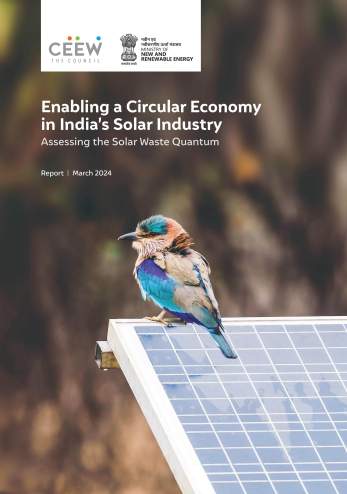
Enabling a Circular Economy in India’s Solar Industry
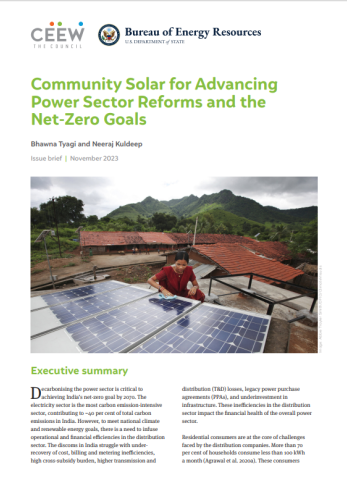
Community Solar for Advancing Power Sector Reforms and the Net-Zero Goals
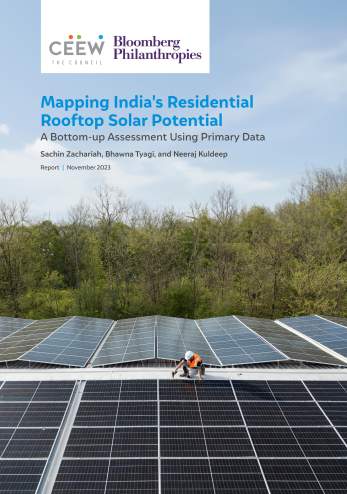
Mapping India’s Residential Rooftop Solar PotentialA bottom-up assessment using primary data
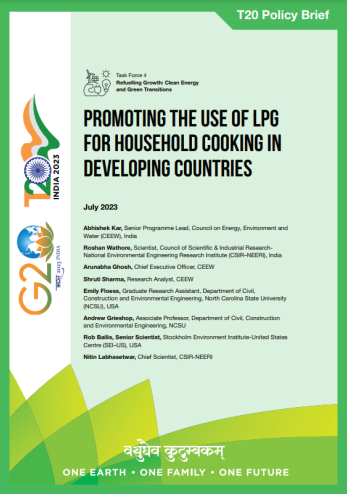
Promoting the Use of LPG for Household Cooking in Developing Countries